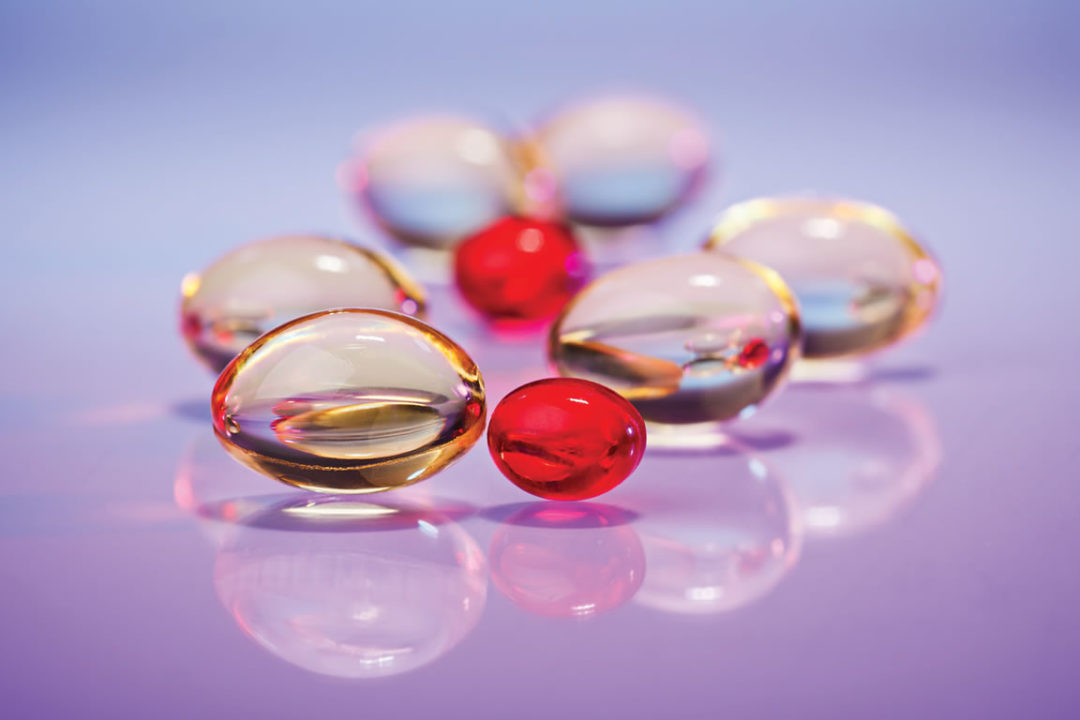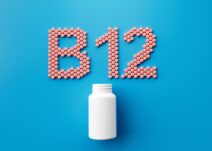Recently, Astaxanthin, a naturally-occurring carotenoid, has become a popular supplement for its unique benefits, particularly its protection against cellular damage, especially in the brain and vascular system. However, what many shoppers may not know or focus on is the vital role Astaxanthin can also play in helping to relieve pain and inflammation, support eye health and even help reduce damage from the sun.
Where Does Astaxanthin Come From?Astaxanthin is produced by the microalgae, Haematococcus pluvialis, when its water supply dries up, forcing it to protect itself from a lack of nutrition and ultraviolet radiation by using astaxanthin as a “force field” (1). Although astaxanthin is produced in algae, it can also be found in marine animals such as salmon, shrimp and lobster, which consume the algae and in turn gives these animals its pink flesh color and even aids in salmon’s strength and endurance to swim up-river and through waterfalls (1). Unfortunately these sources contain only trace amounts of astaxanthin and since humans cannot synthesize the carotenoid, this potent antioxidant must be consumed via a dietary supplement to acheive sufficient benefits (2).
What Are the Benefits of Astaxanthin?Because astaxanthin is an antioxidant, it naturally neutralizes free radicals, that can harm our cells. However, unlike most antioxidant vitamins and minerals that lose their antioxidant function once a free radical has been disarmed, astaxanthin remains active and can disarm several free radicals at one time, making it a more efficient antioxidant (3).
Skin Health.Radiant, vibrant, and healthy looking skin has long been associated with good health, but while most try and improve the appearance of their skin from the outside alone, the real key to healthy skin is building it from the inside out (2). Shoppers tend to believe one reason — besides normal aging — skin wrinkles and age spots appear is a result of exposure to the elements such as the sun, wind and pollution. However, another factor may be oxidative damage. As we absorb toxins into our bloodstream, from pollution in the air, from pesticides in the food we eat, or any other factor, in cellular oxidation is the result. Cellular oxidation can damage cell membranes and other structures such as the collagen in our skin, which can then become thinner, lose the ability to hold its shape and become less elastic eventually forming wrinkles. Besides trying to avoid toxins to prevent the signs of premature aging, astaxanthin may be able to significantly reduce the oxidative load in the body by protecting the cells against oxidation (4). In a study published in Acta Biochimica Polonica in 2012, two human clinical trials were performed. In the open-label non-controlled study, which for eight weeks involved 30 healthy female subjects, a combination of 6 mg of oral supplementation and 2 ml of a topical application of astaxanthin per day, lead to an improvement of the patient’s skin texture by week four and improvements in age-spot size, moisture content, elasticity and skin wrinkles by week eight. In the second trial, which was a randomized double-blind placebo-controlled study that involved 36 healthy males, researchers found that after six weeks of taking 6 mg of an oral astaxanthin daily, patients had an improvement in crow’s feet wrinkles, elasticity and transepidermal water loss.
Eye and Brain Support. To help combat free radicals from enacting oxidative damage in the retina, two carotenoids, zeaxanthin and lutein, are concentrated in the macula of the retina. However as one ages, the body begins to lose the ability to produce high levels of the antioxidants it needs to fight off toxins that are targeting one’s organs and even fight off light damaging exposure such as high-energy light rays called blue light, which can reach deep into the eye, causing damage to the retina and has even be theorized in the development of age-related macular degeneration. While shoppers may believe the simple solution is to head for a supplement containing zeaxanthin and lutein, new research suggests grabbing an astaxanthin supplement in combination with or even alone. This is due to its ability, unlike other carotenoids, to cross the blood-brain barriers and the blood-retinal barrier to bring antioxidant and anti-inflammatory effects to stop retinal destruction.
In a four-week double-blind study, published in the Journal of Traditional Medicines, researchers found supplementation with 5 mg of astaxanthin resulted in a 46% reduction of eyestrain or fatigue and a higher accommodation amplitude (the adjustment in the lens that allows it to focus) in patients who used visual display terminals (2,5).
Beyond eye health, researchers have also been able to see a vast improvement in brain health. In one study, published in the British Journal of Nutrition in 2011, researchers found patients taking 6 or 12 mg of astaxanthin per day for 12 weeks to have a reduction in levels of phospholipid hydroperoxides (PLOOH), which accumulates abnormally in the red blood cells of people with dementia.
Cardiovascular Health. Cardiovascular disease causes more than 17 million deaths worldwide each year and is also responsible for half of all deaths in the United States (6). Any health problem directly affecting the heart or the blood vessel and arteries can be classified as a cardiovascular disease, such as, atherosclerosis, high blood pressure, arteriosclerosis, abnormal heart arrhythmia and cardiomyopathy. In a recent study involving obese adults, astaxanthin has been shown to lower LDL cholesterol, ApoB and oxidative stress biomarkers (7). Another study with participants taking 6 mg of astaxanthin per day for 10 days showed an improvement in blood circulation, which may also help those with hypertension, a condition in which blood pressure in the arteries is elevated requiring the heart to pump harder to circulate blood (8).
Inflammation & Pain.Inflammation is the body’s response to fighting infection and repairing tissues. When one sprains their ankle, a muscle or tears a ligament, the body’s inflammatory response kicks in causing inflammation to form around the affected area and the stages of healing begin. But when inflammation lingers, it can cause tissue damage and inflammatory conditions such as osteoarthritis, rheumatoid arthritis, asthma and more. Astaxanthin’s ability to travel throughout the body allows it to target a number of high-stress inflammatory areas such as the joints, the heart, the brain, the eyes, and the skin (2). Unfortunately, research is still ongoing as to how astaxanthin blocks inflammatory COX2 enzymes, while at the same time suppressing serum levels of nitric oxide, interleukin 1B, prostaglandin E2, C Reactive Protein (CRP), and TNF-alpha (tumor necrosis factor alpha) (9).
If shoppers are worried about the potential for toxicity, astaxanthin, unlike most antioxidants lacks the ability to turn into a pro-oxidant, even at high levels due to its molecular structure (10). Of course shoppers should always consult with a physician before adding astaxanthin to their diets.
References1. Joseph Mercola. “Astaxanthin: The Most Important Carotenoid for Healthy Eyes (No, it’s Not Carrots),” May 14, 2011, http://articles.mercola.com/sites/articles/archive/2011/05/14/astaxanthin-the-worlds-strongest-antioxidant.aspx, accessed January 5, 2017.
2. Michael T. Murray. “The Whole Body benefits of Natural Astaxanthin,” November 23, 2016, http://xdigital.spiweb.com/publication/
?i=360127#{“issue_id”:360127,”page”:0}, accessed January 5, 2017.
3. Brandi Black. “What is Astaxanthin?” https://www.sunchlorellausa.com
/astaxanthin-benefits-a/436.htm, accessed January 5, 2017.
4. Nutrex Hawaii. “Astaxanthin Explained,” http://www.nutrex-hawaii.com/astaxanthin-explained, accessed January 5, 2017.
5. Nagaki, Y., Hayasaka, et al. (2002). “Effects of astaxanthin on accommodation, critical flicker fusion, and pattern visual evoked potential in visual display terminal workers.” Journal of Traditional Medicines. 19(5): 170-173
6. Texas Heart Institute, “Heart Disease Risk Factors,” www.texasheart.
org/HIC/Topics/HSmart/riskfact.cfm, accessed Aug. 25, 2016.
7. Choi HD, Youn YK, Shin WG. “Positive effects of astaxanthin on lipid profiles and oxidative stress in overweight subjects,” Plant Foods for Human Nutrition. 2011 Nov;66(4):363-9.
8. Miyawaki, H., et al. (2008). “Effects of astaxanthin on human blood rheology,” Journal of Clinical Biochemistry Nutrition. 43(2): 9–74.
9. Nutrex Hawaii. “Benefits of Astaxanthin,” http://www.nutrex-hawaii.com/benefits-of-astaxanthin, accessed January 5, 2017.
10. Joseph Mercola. “Astaxanthin – Nature’s Most Powerful Antioxidant,” February 10, 2013, http://articles.mercola.com/sites/articles/archive/
2013/02/10/cysewki-discloses-astaxanthin-benefits.aspx, accessed January 5, 2017.
Published in WholeFoods Magazine February 2017

2025 Natural Choice Awards
March 31, 2025








